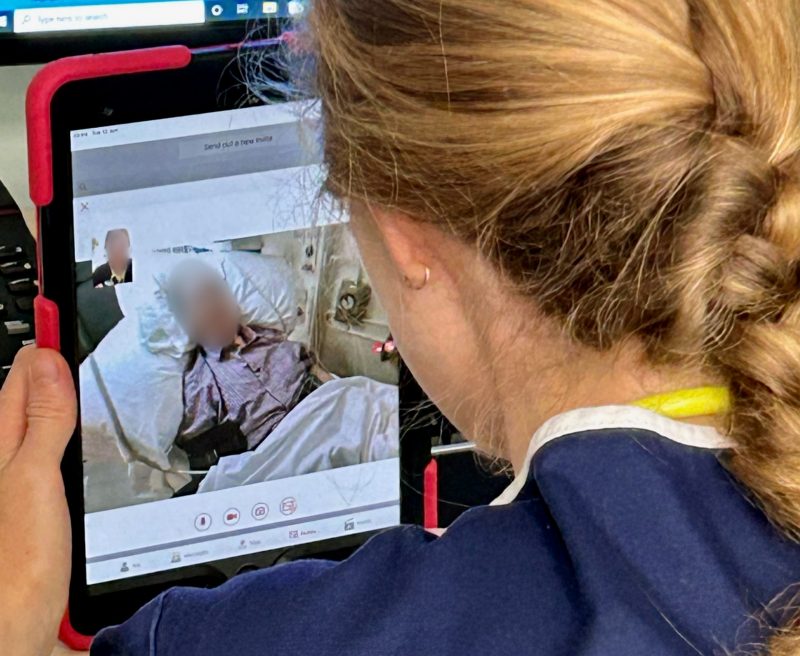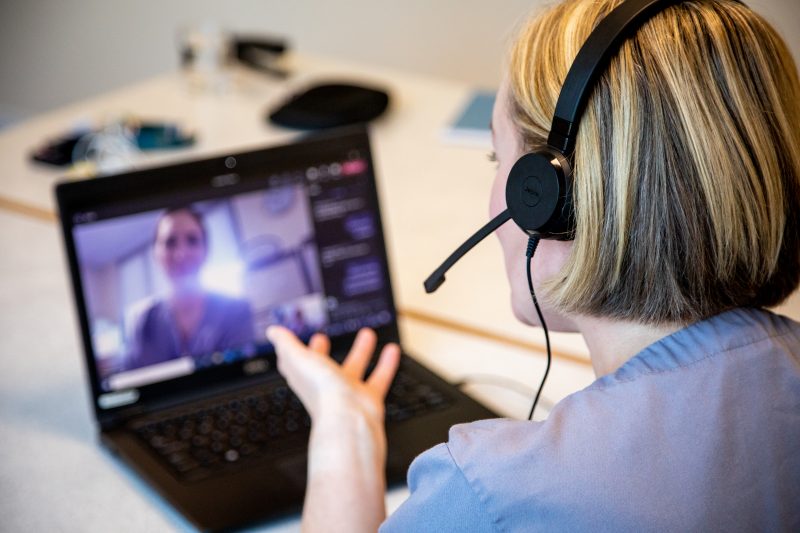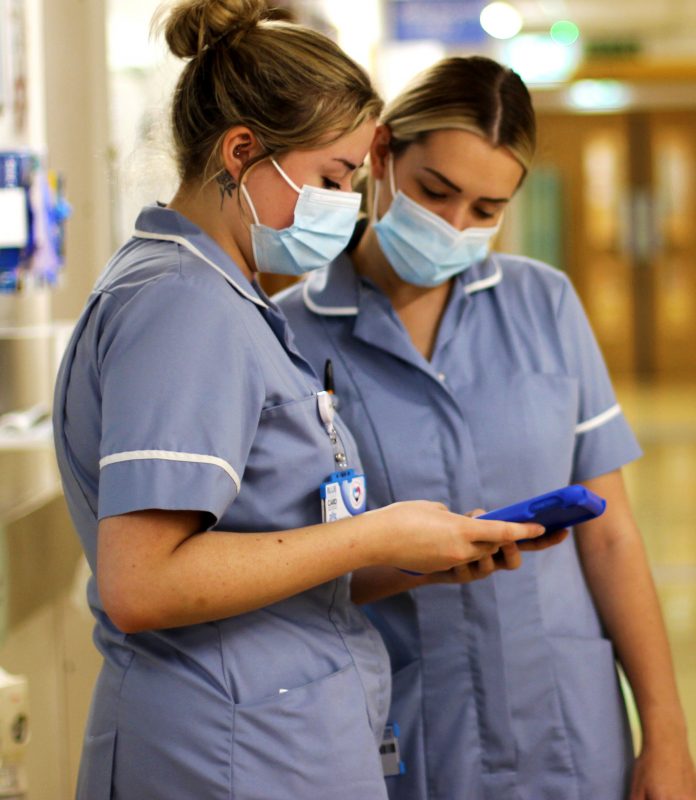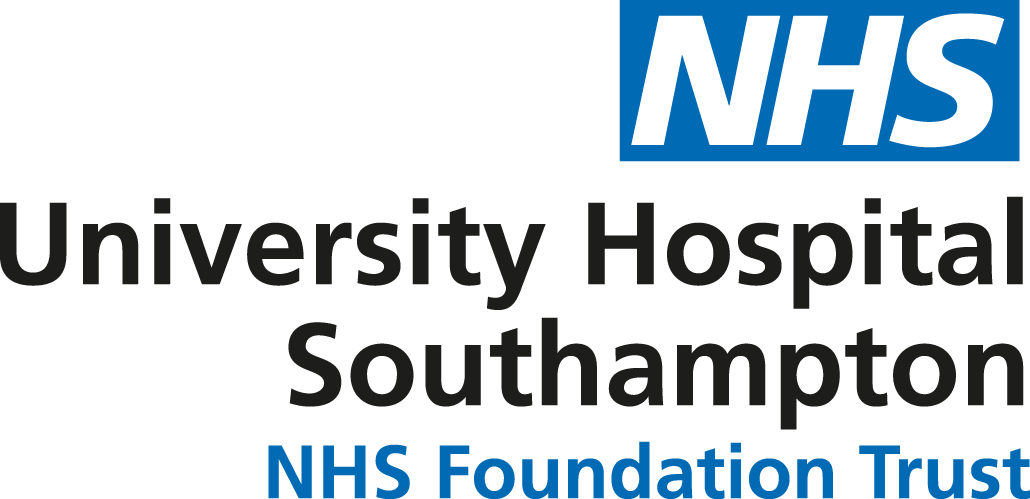A new use of digital technology can lead to better treatment for patients and greater efficiencies for the trust.
Assessing stroke patients by video call before they reach the hospital can revolutionise patient care, writes Consultant Stroke Physician Dr Richard Marigold

A specialist stroke nurse communicates with paramedics in the ambulance
Here at University Hospital Southampton, we are excited to have recently launched a new system that uses digital technology to help us identify and treat potential stroke patients more quickly and efficiently than before.
The Virtual Stroke Assessment Pilot Scheme is a pre-hospital, video-triage system that is currently being piloted at nine hospitals across England, thanks to a funding grant from NHS England.
How it works
It works by using digital technology to allow paramedics to make video calls to specialist nurses in the hospital in order to triage potential stroke patients by video in the ambulance before they arrive at the hospital.
By establishing a video link between the paramedic team and stroke specialists, we can review the patient as they are coming into hospital and determine whether we think they have had a stroke or not.
If they have had a stroke, we can fast track them to the CT scanner and pre-alert our teams to the possibility of the patient needing thrombolysis or thrombectomy.
We calculate that this new approach can save around 15-20 minutes in getting stroke patients the treatment they need by avoiding the need to complete the triage process when they arrive at the hospital.
That may seem like a relatively short amount of time, but in the context of stroke it can be crucial.
For every half an hour you delay treatments in this setting, patients have a 10% less likely chance of returning to independent living.
So it’s relatively small amounts of time that can make a big difference to outcomes.
The scheme also has a double benefit in that it helps us identify patients who haven’t had a stroke earlier, helping us sift out patients and asking the Emergency Department or other Impatient teams to see them.
In doing this we can also provide those teams with a provisional diagnosis from us as to what we think the problem is.

Use of video calls for consultation has increased in recent years
Delivering efficiencies
This improves our operational efficiencies as the number of referrals to the stroke service is rising exponentially.
In 2022 we had 3,600 referrals, however, many of the cases we actually see are not due to a stroke, they have other causes such as migraine headaches, epileptic seizures, infection, low blood pressure and unexplained neurological symptoms being common examples.
In the end, only about 1,100 of the 3,600 referrals that were referred to us turned out to have a stroke diagnosis.
The remainder could have been seen in the Emergency Department, or even, in some cases, not brought into hospital and seen by their GP.
Digital collaboration and challenges
The digital team have been incredibly helpful and constructive in the process, through putting in our initial bid through to creating a business case, ensuring that information governance requirements have been met and that we have had the right devices to use once the project has gone live.
But we have also faced some challenges in introducing digital technology and a new workflow.
There was some scepticism from colleagues about how beneficial it might be, and also a wariness amongst clinicians about using video triage to make a first diagnosis.
However, as we have done more triage cases, our confidence is beginning to grow in using the technology and we discuss each case within the department about the challenges we have found and what we have learnt as we have gone along.
As is often the case in innovating, there were some barriers to change and a concern that it would add to our workload, but once team members realised the benefits of the technology in providing timely advice, and that it reduced the in us not having to review non-stroke cases, the benefits have rapidly become apparent.

UHS staff embrace technology on the wards
Trepidation and excitement
On a personal level, going live with system I felt excitement, a sense of trepidation, but also a real feeling that this will speed up treatment times, enable more timely and better decision making and allow us to focus our efforts on those stroke patients that need our urgent expertise.
The first case we did resulted in a patient having a CT scan within 15 minutes and being admitted to the stroke unit within 45 minutes of arriving in hospital, which is excellent in terms of treatment timings.
For other health professionals considering innovating healthcare with digital technology, I would say: think positively, have a vision about the end point you want to get to, and build a case with colleagues and management about the differences it will make to patient outcomes.
There are many people within the organisation to help you, and don’t be put off by early challenges in getting governance approvals.
Also, ensure you have a robust clinical pathway that protects patient data and confidentiality and has a back-up plan if there are any technological glitches.
In our case if the video triage doesn’t work, the paramedics will still bring the patient in to the Emergency Department for us to review so there is no impact on patient safety.
Going forward
This is an incredibly exciting project which has the potential to revolutionise acute stroke care and enable us to make faster better decisions about our patients.
The app we use to make the video calls can support multiple people joining the call which offers interesting possibilities.
For example, it could be expanded beyond UHS to include regional stroke networks and include four people in a conversation, such as a referring stroke clinician in another hospital, an interventional radiologist and stroke specialist at UHS.
Expanding the use of the technology in this way means we could make decisions about patients further afield and whether to transfer them to their local hospital or to bring them to UHS for stroke treatment.
This will help us in getting the right care to the right patients in a timely way and improve the speed and efficiency in which we can deliver treatments, such as thrombolysis or mechanical thrombectomy, which have a substantial impact in reducing neurological disability.
Simply put, the sooner we can diagnose and treat, the better the outcomes for our patients, and using technology in this way helps us do just that.
